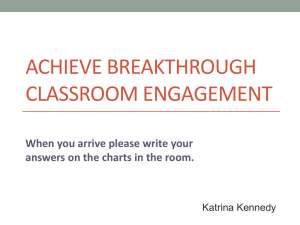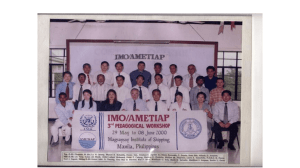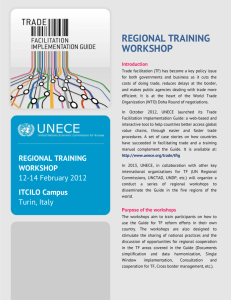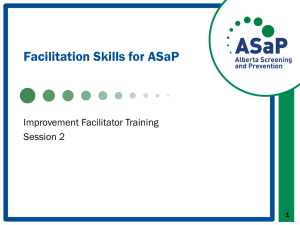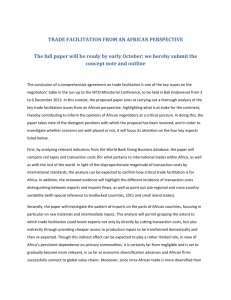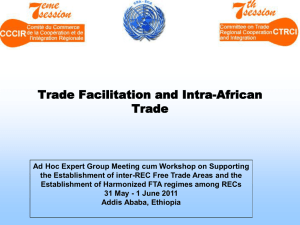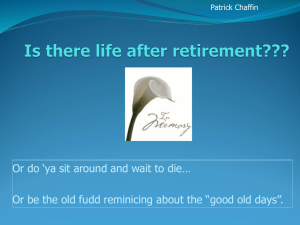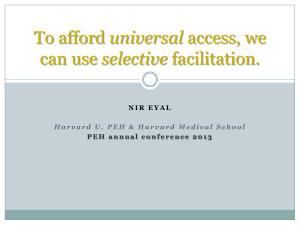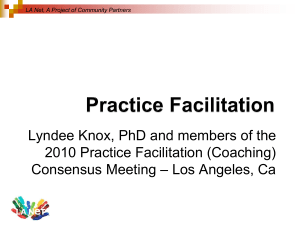workshops
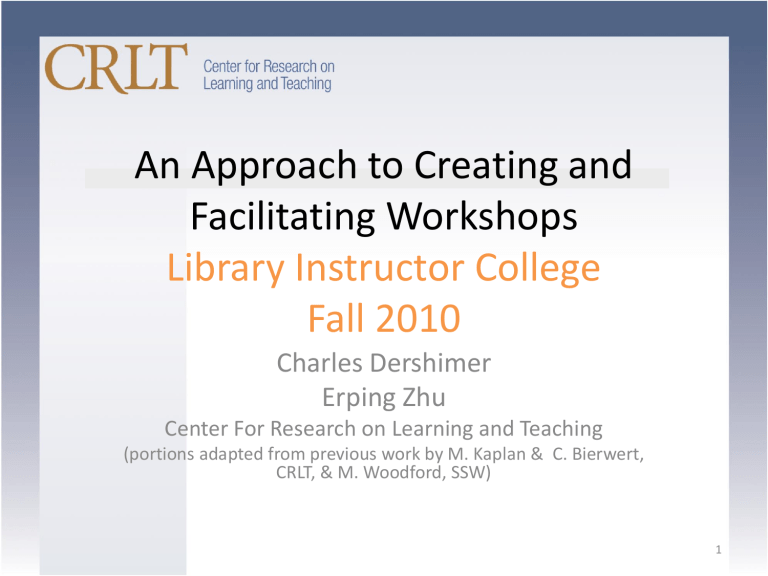
An Approach to Creating and
Facilitating Workshops
Library Instructor College
Fall 2010
Charles Dershimer
Erping Zhu
Center For Research on Learning and Teaching
(portions adapted from previous work by M. Kaplan & C. Bierwert,
CRLT, & M. Woodford, SSW)
1
Goals:
• Identify key elements of workshop planning, facilitation, and assessment
• Apply ideas to planning for upcoming library programs
• Gain useful resources through CRLT/Library collaboration
2
Table Introductions
• Introduce yourself & where you work in library
• Have you taught before and what did you teach?
• What are your goals for today?
REPORT OUT-
Range of “years of experience” & Summarize 1 goal
3
Why use workshops rather than other formats already in use?
Why support a common approach to workshop design?
4
What makes a “workshop?”
WORKSHOP PRESENTATION
Largely one-way communication
Presenters tend to answer most of the questions
Instructional strategies coincide with rote learning or transfer of knowledge
5
What makes a “workshop?”
PRESENTATION
Largely one-way communication
WORKSHOP
Interdependent
Communication
Presenters tend to answer most of the questions
Facilitation of
Questioning
Instructional strategies coincide with rote learning or transfer of knowledge
Active Learning
6
Assumptions About Workshops
• Provides time for reflection, systematic thinking, exchange of ideas
• Collectively participants can contribute a large portion of content and wisdom needed
• Workshops are successful when participants have as many opportunities as possible to acquire wisdom themselves
• Participants like workshops best when they learn something they can use tomorrow
7
Assumptions About Commonalities
• Current instructors have varied experiences
• Feelings of Trust and Logic is important for common ideas to “stick” and be adopted
• Workshops will have a variety of differences in
learners who are present and strategies help address this
• Common assessment is necessary and needed for measured success
8
Key Workshop Considerations
Part 1
• Audience & Goals
Part 2
• Assessment
Part 3
• Sequencing of Activities
• Time Management
• Facilitation
9
Audience Analysis:
• Who are they and why are they attending?
• What are their expectations?
• What do they already know?
• What assumptions will they be making?
• What resistance might they have?
10
Goals:
By the end of the workshop…
• How should participants be different?
• What should they know or be able to do?
• What assumptions and practices should they rethink?
• What resources should they have?
11
Backwards Course Design & Alignment
(Wiggins and McTighe, 2005; Tyler, 1949; Diamond, 1998; Walvoord, 1998)
Backward Design Process
Identify desired results.
Learning
Objectives
Alignment
Learning
Objectives
Determine acceptable evidence.
Evaluation or
Assessment
Methods
Teaching
Methods
Evaluation or
Assessment
Methods
Teaching
Methods
Plan learning experiences and instruction.
Good Alignment Poor Alignment
12
Assessment
“knowledge, through evidence, about what has changed”
13
Bloom’s Taxonomy
(Anderson & Krathwohl, 2000)
14
Activity 1 – Addressing Goals
Examine goals for a workshop by table:
1.Who is the audience?
2.How clear are the workshop goals for this audience?
3.How do the workshop goals represent the
range in Bloom’s Taxonomy?
4.How measureable are the workshop goals?
15
Part 2 Assessment:
16
Assessment: Why Do it
• Feedback on course & practices
Common questions for evaluating workshop effectiveness
• Data for year end report
Common theme for reporting success
17
Assessment: How do it
• Formative – Throughout session
“Classroom Assessment Techniques”
• Summative – Capstone activity to check goals
• Programmatic – Last 5 minutes for participant survey
18
Activity 2 – Assessment
Group 1 Review Assessment Handout…
• In a small group, discuss which CAT to use, when, and for what reasons.
Group 2 Review Survey Questions…
• In a small group “How might these survey questions be useful for formative, summative, or programmatic assessment?”
19
Part 3
Activity Sequencing and Facilitation
20
7 Principles for Good Practice
1. Encourage Student-Instructor Contact
2. Encourage Cooperation Among Students
3. Encourage Active Learning
4. Give Prompt Feedback
5. Emphasize time on task
6. Communicate High Expectations
7. Respect Diverse Talents & Ways of Learning
(Chickering & Gamson, 1987)
21
Alignment of Goals and Methods
• Exposure to new information
– Mini Lectures, panels, data presentation, readings
• Develop new skills
– Explanation demonstration practice & feedback
– Role playing, application activities, see – do - teach
• Problem solving: analysis and evaluation
– Case studies, skits, video analysis, brainstorming
22
Alignment of Goals and Methods
• Reflection
– Writing, case studies, skits, self-assessment checklists
• Collaborative Learning
– Think-pair share, small group exchanges, discussions
23
Sequencing a Workshop
• Opening
– Set positive tone of trust and interactivity (feel)
– Be explicit about goals, assumptions, agenda (logic)
• Body
– Provide new information
– Provide chances for higher order thinking
– Order depends on goal (inductive or deductive)
• Ending
– Make opportunities to synthesize and consolidate
– Evaluation and Feedback
– Next steps
24
Time Management
• Set realistic timelines – practice
• Build in time to think – not just cover topics
• Create space – for discussion and learning from mistakes
• Be flexible – but firm about agenda to honor participants time
25
Activity 3 – Pause & Reflect
Using the Lesson Plan..
1.Identify steps in the lesson where Active
Learning techniques are beneficial to supporting the lesson goals.
2.Identify any other techniques from the active learning continuum that would also help achieve the lesson goals.
26
Workshop Facilitation
We promote a “learning orientation” with questioning, responding, involvement
27
Workshop Facilitation
A “learning orientation” helps participants:
• Identify with the topic
• Understand why it is important to them
• Explore what they already know
• Learn new information from others
• Integrate the information, skills, or wisdoms
28
Workshop Facilitation: Questioning
Individual
• Draw out information as needed
• Mix both “close-ended” and “open-ended”
Group
• Invite everyone to participate
• Risk involved, support participation
29
Workshop Facilitation: Responding
Individual
• Acknowledge input
• Stay neutral but correct errors to educate
Paraphrasing
• Key point in your own words
• Reinforce contribution, encourage others
30
Workshop Facilitation: Involvement
• Keep participants active
• Link past and present experiences
• Use experiences as learning resources (feel)
• Affirm participant’s knowledge and needs
(logic)
31
Activity 4 – Facilitation
Based on Past Experiences…
1.Identify 2 facilitation techniques you have used that were useful and describe why.
2.In a small group, discuss your techniques
3.Be ready to share some with the large group
32
Overall: Workshop Design
Audience & Goals
Alignment
Effective
Workshop
Design
Facilitation
Formative, Summative, and Programmatic
Feedback
33
